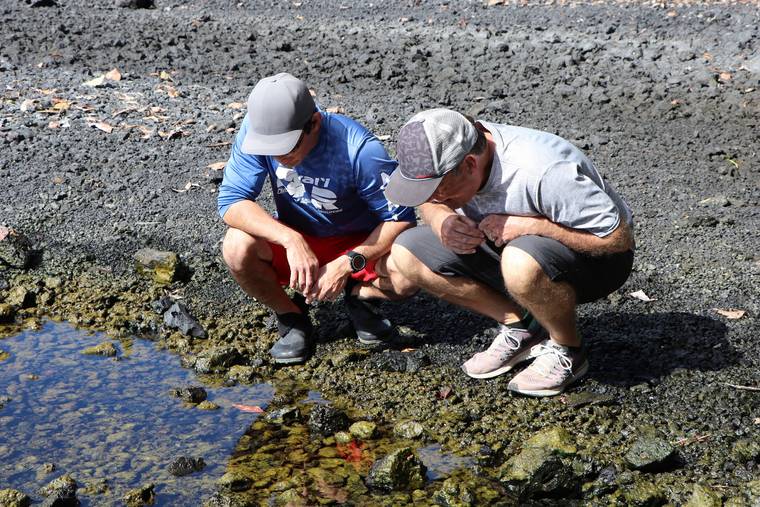HILO — A biologist for the Department of Land and Natural Resources Division of Aquatic Resources said Friday it’s important to protect anchialine pools that formed along the new black sand beach at Pohoiki.
Troy Sakihara, describing anchialine pools as “brackish water pools that are landlocked, but are connected to the ocean and groundwater through the underground,” said they “are home to an array of endemic species found only in Hawaii.”
“Most of them are shrimps,” Sakihara said. “The most common and most popular and well-known is the ‘opae‘ula, which is the tiny red shrimp that many people have in their own aquariums. But they’re also a very important species for the ecosystem, these anchialine habitats.”
According to Sakihara, the ‘opae‘ula are important because “they graze quite aggressively.”
“They graze in the pools 24 hours a day, and they keep the ecosystem in check,” he said.
Biologists say they aren’t surprised ‘opae‘ula and other native shrimp are beginning to show up at Pohoiki and likely in other anchialine pools up and down the Puna coastal areas that were inundated by lava flows. The where and how of their reappearance is still a bit of a mystery, but experts do know that they quickly re-inhabit bomb impact craters at places like Kahoolawe.
“It is still a question that we’re trying to answer, as far as how they (appear) so fast into these pools,” Sakihara said.
Sakihara said there are only about 1,000 anchialine pools in the world, and the majority, about 600, are in Hawaii. He said DAR has “recorded about seven, so far” of the new pools around the black sand beach, which formed after lava from last year’s lower East Rift Zone eruption of Kilauea volcano entered the ocean along the Puna coastline.
“Some of them are tiny pools, only a few meters across. But there are others that people have been wading in or swimming in that might be 20 meters or so across,” Sakihara said.
He said there are other anchialine pools that have formed on the new lava flows in lower Puna, but DAR hasn’t yet studied them because they are more remote.
On a recent visit to Pohoiki, Sakihara and Brian Neilson, a DAR administrator, watched a woman with a snorkel float in one of the new anchialine pools for more than an hour. Neilson called the pools “really valuable resources – ecologically, biologically and culturally.”
“Our team is currently working on a rules package to provide better management strategies for anchialine pools,” he said. “One of the things people can do right now is to stay out of these sensitive areas. Sunscreens and other body oils can degrade water quality and potentially kill creatures like the ‘opae‘ula.
“We want to educate folks and ask them not to disturb these pools and minimize their interactions with them. Please don’t swim or snorkel in them, as you may be killing some of the most endangered aquatic creatures in the state. Respect them and enjoy them — with your eyes, only.”
Sakihara added the pools are of historic cultural importance to Native Hawaiians.
“Hawaiians used anchialine pools as sources of fresh water, especially in Kona, where you don’t have any streams or readily available sources of fresh water, aside from these pools along these coastline. And the salinity fluctuates in these pools. They can get down to near fresh water to almost sea water,” he said.
According to Sakihara, the salinity of the Pohoiki pools is about 14 to 15 parts per thousand, compared to fresh water, which has zero salinity, and sea water, which has about 33-35 parts per thousand of salt.
Pohoiki is home to a formerly busy boat ramp — the only boat ramp between Hilo and Milolii — that was landlocked by the newly formed black sand beach. There has been talk about the possibility of dredging a channel so fishing and tour boat operators can once again use the boat ramp.
“These pools have popped up kind of away from the boat ramp. There are ones that are right there, as well,” he said. “There may be some anchialine habitats that might be lost if they do decide to dredge. But there are others in the vicinity and along the coastline that I believe wouldn’t be affected by the dredging, but it’s hard to say. That coastline, it’s still constantly changing. That beach is still increasing in size, as far as I’m aware. So what we say now may be completely different later.”
While authorities are formulating protective measures for the pools, Sakihara said they “can’t stop anyone from entering these pools or swimming in these pools.”
“As far as the rules that we’re considering, it revolves around the taking of ‘opae‘ula or introduction of fish to these ponds, which is one of the threats that we’re facing,” he said. “Unfortunately, most of the anchialine ponds that we have statewide are already impacted by invasive species — invasive fish or plants — or touched by human interactions and pollution. And we don’t have any rules that are specific to anchialine habitats, so that’s what want to address in the near future.
“It’s more about protecting the ones we have already and new ones that form.”
Email John Burnett at jburnett@hawaiitribune-herald.com.



